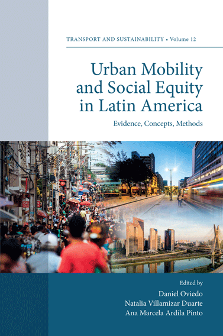
Index
Urban Mobility and Social Equity in Latin America: Evidence, Concepts, Methods
ISBN: 978-1-78769-010-3, eISBN: 978-1-78769-009-7
ISSN: 2044-9941
Publication date: 16 November 2020
Citation
(2020), "Index", Oviedo, D., Duarte, N.V. and Pinto, A.M.A. (Ed.) Urban Mobility and Social Equity in Latin America: Evidence, Concepts, Methods (Transport and Sustainability, Vol. 12), Emerald Publishing Limited, Leeds, pp. 239-244. https://doi.org/10.1108/S2044-994120200000012016
Publisher
:Emerald Publishing Limited
Copyright © 2021 Emerald Publishing Limited
INDEX
- Prelims
- Urban Mobility and Social Equity: An Introduction
- Chapter 1: Should Urban Transport Become a Social Policy? Interrogating the Role of Accessibility in Social Equity and Urban Development in Bogotá, Colombia
- Chapter 2: Mobility and Gender Equity in Latin America: Different Mobile Burdens and Contributions in Montevideo (Uruguay)
- Chapter 3: Children and Urban Mobility: Care Dynamics on Family Mobility Patterns
- Chapter 4: ‘Like Sardines in a Can’. Gender, Stratification and Mobility in the Lives of Female Household Employees in Bogotá, Colombia
- Chapter 5: Sustainable Transport and Gender Equity: Insights from Santiago, Chile
- Chapter 6: Gendered Exploration of Emotive and Instrumental Well-Being for Cyclist Woman in Latin America
- Chapter 7: Active Commute to School, Physical Activity and Health of Hispanic High School Students in the United States
- Chapter 8: Children’s Mobility and Playability in the Neighbourhood of Río Piedras: Perspectives from Children and Adults
- Chapter 9: Mobility and Equity: The Problem of Access to City Spaces by Individuals Submitted to Psychiatric Hospitalisation
- Chapter 10: Urban Accessibility in Belo Horizonte, Brazil: A Case Study of Mobility Practices and Demands of People with Disabilities in the Mobility Systems
- Epilogue
- Index